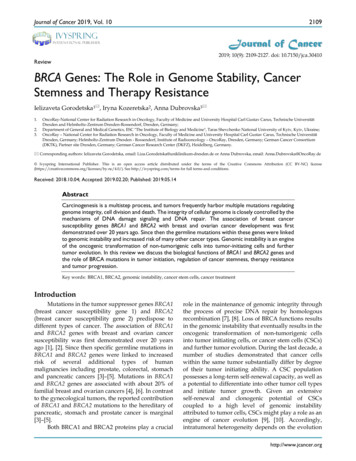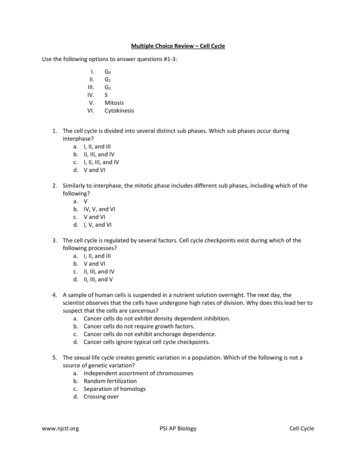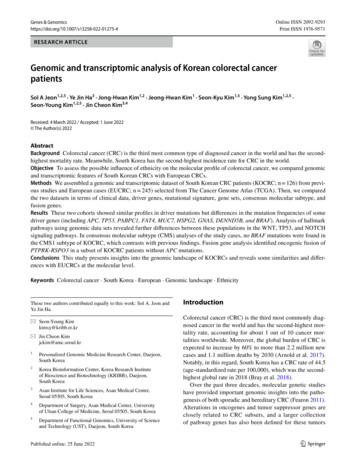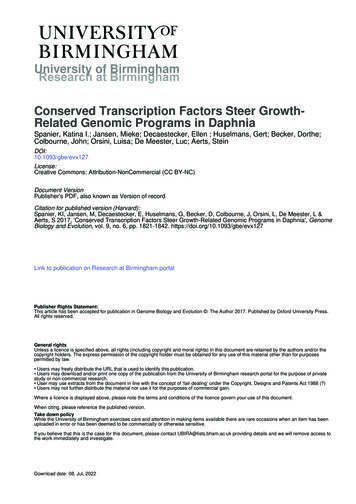
Transcription
Journal of Cancer 2019, Vol. 102109IvyspringJournal of CancerInternational Publisher2019; 10(9): 2109-2127. doi: 10.7150/jca.30410ReviewBRCA Genes: The Role in Genome Stability, CancerStemness and Therapy ResistanceIelizaveta Gorodetska1 , Iryna Kozeretska2, Anna Dubrovska3 1.2.3.OncoRay-National Center for Radiation Research in Oncology, Faculty of Medicine and University Hospital Carl Gustav Carus, Technische UniversitätDresden and Helmholtz-Zentrum Dresden-Rossendorf, Dresden, Germany;Department of General and Medical Genetics, ESC "The Institute of Biology and Medicine", Taras Shevchenko National University of Kyiv, Kyiv, Ukraine;OncoRay – National Center for Radiation Research in Oncology, Faculty of Medicine and University Hospital Carl Gustav Carus, Technische UniversitätDresden, Germany; Helmholtz-Zentrum Dresden - Rossendorf, Institute of Radiooncology – OncoRay, Dresden, Germany; German Cancer Consortium(DKTK), Partner site Dresden, Germany; German Cancer Research Center (DKFZ), Heidelberg, Germany. Corresponding authors: Ielizaveta Gorodetska, email: Liza.Gorodetska@uniklinikum-dresden.de or Anna Dubrovska, email: Anna.Dubrovska@OncoRay.de Ivyspring International Publisher. This is an open access article distributed under the terms of the Creative Commons Attribution (CC BY-NC) /4.0/). See http://ivyspring.com/terms for full terms and conditions.Received: 2018.10.04; Accepted: 2019.02.20; Published: 2019.05.14AbstractCarcinogenesis is a multistep process, and tumors frequently harbor multiple mutations regulatinggenome integrity, cell division and death. The integrity of cellular genome is closely controlled by themechanisms of DNA damage signaling and DNA repair. The association of breast cancersusceptibility genes BRCA1 and BRCA2 with breast and ovarian cancer development was firstdemonstrated over 20 years ago. Since then the germline mutations within these genes were linkedto genomic instability and increased risk of many other cancer types. Genomic instability is an engineof the oncogenic transformation of non-tumorigenic cells into tumor-initiating cells and furthertumor evolution. In this review we discuss the biological functions of BRCA1 and BRCA2 genes andthe role of BRCA mutations in tumor initiation, regulation of cancer stemness, therapy resistanceand tumor progression.Key words: BRCA1, BRCA2, genomic instability, cancer stem cells, cancer treatmentIntroductionMutations in the tumor suppressor genes BRCA1(breast cancer susceptibility gene 1) and BRCA2(breast cancer susceptibility gene 2) predispose todifferent types of cancer. The association of BRCA1and BRCA2 genes with breast and ovarian cancersusceptibility was first demonstrated over 20 yearsago [1], [2]. Since then specific germline mutations inBRCA1 and BRCA2 genes were linked to increasedrisk of several additional types of humanmalignancies including prostate, colorectal, stomachand pancreatic cancers [3]–[5]. Mutations in BRCA1and BRCA2 genes are associated with about 20% offamilial breast and ovarian cancers [4], [6]. In contrastto the gynecological tumors, the reported contributionof BRCA1 and BRCA2 mutations to the hereditary ofpancreatic, stomach and prostate cancer is marginal[3]–[5].Both BRCA1 and BRCA2 proteins play a crucialrole in the maintenance of genomic integrity throughthe process of precise DNA repair by homologousrecombination [7], [8]. Loss of BRCA functions resultsin the genomic instability that eventually results in theoncogenic transformation of non-tumorigenic cellsinto tumor initiating cells, or cancer stem cells (CSCs)and further tumor evolution. During the last decade, anumber of studies demonstrated that cancer cellswithin the same tumor substantially differ by degreeof their tumor initiating ability. A CSC populationpossesses a long-term self-renewal capacity, as well asa potential to differentiate into other tumor cell typesand initiate tumor growth. Given an extensiveself-renewal and clonogenic potential of CSCscoupled to a high level of genomic instabilityattributed to tumor cells, CSCs might play a role as anengine of cancer evolution [9], [10]. Accordingly,intratumoral heterogeneity depends on the evolutionhttp://www.jcancer.org
Journal of Cancer 2019, Vol. 10of CSCs that is reflected in the number of emergingtumor clones.Until recently, the role of DNA repairmechanisms and, in particular, BRCA proteins inregulation of CSC populations was not clear. Over thelast years several seminal studies highlighted the roleof BRCA proteins in the maintenance and evolution ofthe CSC populations. This review focuses on thecellular mechanisms deregulated in BRCA mutatedcancers which appear to be important for CSCdevelopment, maintenance and therapy resistance.BRCA genes, BRCA proteins and theirclinical relevanceTumor suppressor genes BRCA1 and BRCA2were first linked to the breast and ovarian cancersusceptibility by Mick and colleagues in 1994 (BRCA1)[1] and by Wooster et al. in 1995 (BRCA2) [2]. Sincethen the number of studies demonstrated a role ofBRCA genes in the different cellular processesregulating tumor development has grown dramatically. BRCA1 (17q21, chromosome 17: base pairs43,044,294 to 43,125,482) is a 1,863 amino acids proteincomposed of 24 exons. It consists of several domainsthat are essential for its multiple functions. At theN-terminal region it carries zinc-binding fingerdomain RING (Really Interesting New Gene) which isessential for interaction of BRCA1 and BARD1(BRCA1 Associated RING Domain protein 1) andformation of E3 ubiquitin ligase complex [11]. At theC terminus two phosphopeptide-binding BRCT(BRCA1 C-terminal) domains [12] are mediatinginteraction of BRCA1 with key partner proteins suchas CtIP (C-terminal binding protein 1 (CtBP1)interacting protein), BRCA1 A Complex Subunit(ABRAXAS), and BRCA1 interacting proteinC-terminal helicase 1 (BRIP1/ FACJ) [13]. The centralpart of BRCA1 is encoded by exons 11-13 and themutations in these regions are frequently detected inbreast cancer patients. These parts consist of twonuclear localization signals (NLS) and one coiled coildomain which is important for interaction withBRCA2 through partner and localizer of BRCA2(PALB2) [14], [15] (Figure 1).More than 1600 mutations were identified inBRCA1 gene including deletions, insertions, andmany single nucleotide polymorphisms in the codingor noncoding sequences [16]. Some of them occurwith high frequency in isolated groups and are calledfounder mutations. The most frequently identifiedBRCA1 mutations are located in the gene regionscorresponding to the BRCT and RING domains aswell as in the exons 11-13 encoding NLS essential forBRCA1 functions and binding sites for differentBRCA1-interacting proteins including c-Myc, Rad50,2110pRb, Rad51, BRCA2 and PALB2 [17]. A foundermutation 185delAG in the region of RING and BRCTdomains was found among Ashkenazi Jews [18], and5382insC frameshift mutation arose in either Scandinavia or northern Russia [19]. A number of mutationsin exon 11-13 of BRCA1 gene were associated withbreast and ovarian cancer [20], [21]. The majority ofthe lesions in BRCA1 gene are frameshift isruptions of splice site resulting in missensemutations or expression of non-functional proteins[22], [23]. In general, mutations in BRCA1 genepredispose to the different cancer types, such as breastand ovarian cancer in women, male breast cancer andprostate cancer. In addition, BRCA1 mutation carriersmay be at high risk for the development of other typesof cancer including colon, rectal, pancreatic cancer[24] as well as stomach cancer [25].BRCA2 (13q12.3, chromosome 13: base pairs32,315,479 to 32,399,671) is a large 3418 amino acidsprotein. It contains 27 exons and covers approximately 84.2 kb of genomic DNA. At the N-terminusBRCA2 contains a transcriptional activation domain(TAD). The middle part is encoded by exon 11 andcontains eight conserved motifs termed BRC repeatsthat bind to RAD51 [26]. A DNA-binding domain islocated in the carboxyl terminus of the BRCA2 proteinand assembled of a conserved helical domain, threeoligonucleotide binding (OB) folds and a towerdomain (T), which facilitates BRCA2 binding todouble-stranded DNA (dsDNA) and single-strandedDNA (ssDNA) [27]. The C terminus of BRCA2contains two NLS and one TR2 domain (Figure 1).As of today, more than 1800 mutations havebeen identified in BRCA2 [16]. These lesions mainlyinclude frameshift insertions, deletions and nonsensemutations and result in premature truncation ornon-functional protein [28]. The most frequentlyidentified germline frameshift mutation 6174delT wasfound in exon 11 of BRCA2 gene in an AshkenaziJewish population [29]. Mutations in BRCA2predispose not just to breast, ovarian and prostatecancer, but are also associated with malignantcutaneous and ocular melanoma, pancreatic, gallbladder, bile duct and stomach cancer [30].The relationship between the domain functionsof BRCA1/2 proteins and tumor development havebeen intensively investigated in animal models asreviewed elsewhere [13], [31], [32] although theresults of these studies are still awaiting to beconfirmed by clinical data. About 70–80% of themutations in BRCA genes result in proteindysfunction or absence of protein product. Thesemutations were confirmed as clinically relevant andare associated with an increased risk for developmenthttp://www.jcancer.org
Journal of Cancer 2019, Vol. 10of hereditary malignancies [33]. Many studies havealso reported an association of BRCA1/2 mutationswith tumor aggressiveness and poor clinical outcomesin cancer patients. Large number of studiesdemonstrated the association of BRCA1/2 mutationsin prostate cancer patients with an increased rate ofintermediate- and high risk disease [34]–[37]. Resentstudy of 603 sporadic pancreatic cancer patients inChina revealed an association between germlinemissense variant rs1799966 (c.4837A G[p.Ser1613Gly]) within the BRCT domain of BRCA1 gene andlower overall patients’ survival rates [38].On the other hand, clinical studies of potentialcorrelation between BRCA1 and BRCA2 mutationsand outcome in breast cancer patients provideconflicting results. A resent prospective multihospital study for 2733 young women diagnosed withbreast cancer including 388 patients with BRCA1/2mutations showed no difference in overall survivalfor BRCA mutations carriers and non-carriers [39].Moreover, analysis of the 558 patients withtriple-negative breast cancer demonstrated thatBRCA1/2 mutation carriers had better overall survivalthan non-carriers [39]. At the same time, loss ofheterozygosity (LOH) at BRCA1 locus was associatedwith significantly shorter disease-free survival,distant metastasis-free survival, and overall survivalin retrospective study of 202 Japanese patients withinvasive breast cancer [40]. Another retrospectiveanalysis of the pathogenic germline BRCA2 mutationsin 458 Chinese individuals who had breast cancer2111showed that BRCA2 mutation status is associated witha higher rate of lymph node metastases at diagnosisand significantly worse outcomes including diseasefree survival and distant recurrence [41]. The clinicalstudies of ovarian cancer also provide conflicting datafor the effect of BRCA gene mutations on patients’prognosis. A retrospective study for 53 patients withgermline BRCA1 mutations showed that BRCAmutation carriers have more favorable clinicaloutcome than sporadic cancers [42]. Another studywhich analyzed 151 ovarian cancer patients withgermline BRCA1/2 mutations and 119 patients withsporadic ovarian cancer demonstrated that survival ofthe patients with familial ovarian cancer is worsecompared to the patients with sporadic casesindependently of the BRCA1/2 mutation status [43]. Aresent meta-analysis based on 33 clinical studiesshowed that BRCA1 mutations can be associated withimproved overall survival in ovarian cancer patients[44].To further elucidate the effect of BRCA1/2mutations on the prognosis of breast and ovarianpatients, more prospective studies are warrantedregarding the contribution of individual pathologicalmutations to the tumor progression and patients’response to therapy. Better understanding of therelationship between the pathophysiological role ofBRCA mutations and tumor aggressiveness may bebeneficial for a more individualized clinicalmanagement of the BRCA-related cancers.Figure 1. Schematic representation of functional domains within BRCA1 and BRCA2 proteins and the position of several founder mutations.BRCA1 is composed of 23 exons and BRCA2 includes 27 exons. Both genes encode large proteins: BRCA1 consists of 1,863 amino acids and BRCA2 of 3,418 aminoacids. BRCA1 has a highly conserved zinc-binding RING (really interesting new gene) finger domain which is located close to the N-terminus. At the C-terminus, twoBRCT (BRCA1 C-terminal) domains are located. The central part of BRCA1 consists of two NLS (nuclear localization signals) and one coiled coil domain. BRCA2contains eight copies of a 20–30 amino acid repeat, termed BRC repeats. At the amino-terminus, BRCA2 has a TAD (transcriptional activation domain) domain andat the carboxyl-terminus two NLS and one TR2 domain. DNA-binding domain is located close to the C-terminal region and is composed of a conserved helicaldomain (H), three oligonucleotide binding (OB) folds and a tower domain (T). Domains are indicated by violet (BRCA1) and green (BRCA2) boxes. Domain namesare shown above. Exons are indicated by braces. Positions of founder mutations are indicated beneath.http://www.jcancer.org
Journal of Cancer 2019, Vol. 10Biological function of BRCA1 and BRCA2BRCA genes as caretakers of genomic stabilityBRCA1 and BRCA2 proteins play a crucial rolein the process of DNA double strand break (DSB)repair by regulation of homologous recombination(HR) [45]. HR is a high fidelity mechanism of DNArepair with using of homologous template such assister chromatids. Therefore, this process can be activein S and G2 phase of cell cycle when sister chromatidsare available for HR. The homology-directed DNArepair process includes a few steps such aspre-synapsis, synapsis and post-synapsis [46], [47]. Inthe first step the Mre11-RAD50-Nbs1 (MRN) complexand its interacting partner C-terminal binding proteininteracting protein (CtIP) with nuclease activityperforms resection of the DSB ends to generate a 3′ single strand (ss) DNA tail protected fromdegradation by replication protein A (RPA). Next,dependent on BRCA1 and BRCA2 proteins,RAD51-ssDNA filament invades homologous duplexDNA which serves as a template. This generates aD-loop (displacement loop) structure, which is a DNAstructure where the strands of a double strand (ds)DNA are separated for a stretch by a third strand ofDNA. The resulted nucleoprotein-filament searchesfor homologous DNA sequence on the sisterchromatid and invades the duplex to form a jointmolecule. Finally, during post-synapsis RAD51dissociates from dsDNA and the 3′ end of thedamaged DNA is elongated by DNA polymerasesand followed by DNA ligation [48]. The resultedintermediate structures of DNA recombination calledHolliday junctions are further resolved by thedifferent mechanisms as discussed elsewhere [49]resulting in an error-free repair.In addition to its role in HR-dependent DNArepair, BRCA1 also regulates the non-homologousend-joining (NHEJ) repair pathway. NHEJ is one ofthe main DNA repair pathways when the brokenDNA ends are directly ligated without the need for ahomologous template. HR is an error-free repair witha high fidelity at the site of correction, but it needsmore time to complete. In contrast, NHEJ is anerror-prone DNA reparation that causes mutations atthe site of damage with a high frequency. However, itis relatively fast and the most common repairmechanism for DNA DSBs [50]. Classical (C) NHEJpredominates in G0 and G1 but can operate in allphases of the cell cycle. It consists of a few steps: breakrecognition, end-processing and ligation. First, DSBends are recognized by the Ku70/Ku80 heterodimer,which recruits DNA-dependent protein kinase(DNA-PK) and other NHEJ proteins such as DNApolymerase, helicase and ligase. Then DNA-PK2112phosphorylates and recruits endonuclease Artemis,which further processes DSB ends. End ligation isfacilitated by the XRCC4 (X-ray repair crosscomplementing protein 4)/Lig4 [50].In contrast to C-NHEJ mechanism, alternative(A)-NHEJ depends on other factors such as MRNcomplex, CtIP, and poly (ADP-ribose) polymerase-1(PARP-1) that plays a role in the DNA lesion detectionand recruitment of the protein to the sites of DNAdamage [51], [52]. A-NHEJ functions as a backuprepair pathway when C-NHEJ is compromised, andits mechanism is less defined than for C-NHEJ [53].BRCA1 is involved in both, C-NHEJ andA-NHEJ pathways. BRCA1 interaction with theC-NHEJ factor Ku80 stabilizes the Ku heterodimer atDSB sites that is required for precise end-joiningrepair. In contrast, a growing body of evidencesuggests that BRCA1 blocks A-NHEJ throughphosphorylation of BRCA1 at S988 by checkpointkinase 2 (Chk2) [54], [55], but the exact mechanism ofthis regulation is unknown.Studies of BRCA genes revealed their interactionwith HR factors such as RAD51 [56], [57] a centralregulator of the strand exchange [58]. Recent studiesdemonstrated that BRCA1 promotes HR-dependentDNA repair by dephosphorylation of 53BP1(p53-binding protein 1) [59] that consequently resultsin the repair pathway switch from NHEJ to HR.Interaction between BRCA1, CtIP and MRN complexhas been shown to be important for activation of HRby the mechanisms involving CDK (cyclin-dependentkinase)-mediated phosphorylation of CtIP at Ser327[60]. BRCA1 is important for BRCA2 recruitment tothe sites of DNA DSBs during HR, and associationbetween these two proteins is mediated throughinteraction with PALB2/FANCN (Fanconi anemia,complementation group N) protein [15], [61].The role of BRCA2 in repair of DSBs has alsobeen extensively studied. It was demonstrated thatBRCA2 plays an essential role in HR by themechanisms involving recruitment of RAD51 to thesites of DSBs [62]. The loss of BRCA2 leads to genomicinstability and tumorigenesis [56]. This can be, in part,explained by the role of BRCA2 in regulation of theintracellular localization and DNA binding ability ofRAD51 recombinase. After detection of DSB by theMRN complex, the consequent protein phosphorylation and ubiquitination events recruit BRCA1 andCtIP proteins to the site of DNA DSB. Together withExo1 and DNA2-BLM (Bloom syndrome protein)exonucleases, this complex triggers DNA endresection and mobilizes BRCA2 to the sites of DNADSBs. BRCA2 promotes HR by the displacement ofRPA and recruitment of RAD51 recombinase on thesites of DNA damage. BRCA2 directly binds tohttp://www.jcancer.org
Journal of Cancer 2019, Vol. 10RAD51 through its BRC repeats and TR2 domain andtherefore facilitates the loading of RAD51 on ssDNAand a search of homologous DNA template [63]–[65].BRCA2 may function as a complex with RAD51paralogs such as XRCC2 and XRCC3 to facilitate anassembly of RAD51 with ssDNA [66].BRCA2 plays a protective role for the maintenance of genomic stability upon replication stress. Ithas been characterized as a regulator of the stalledDNA replication fork by loading and stabilization ofpolymerized RAD51 onto DNA through binding to itsBRC repeats [67]. At the same time BRCA2 canprevent formation of chromosomal aberrationsduring replication stalling by inhibition of MRE11nuclease [68] (Figure 2). BRCA2 is also recruited by3′-repair exonuclease 2 (TREX-2) complexes forprocessing of R-loops, the structures formed duringtranscription and composed of a DNA-RNA hybridand associated ssDNA [69]. BRCA2 can protecttelomere integrity via loading of RAD51 on telomeresduring S/G2 phase that is evidenced by theaccumulation of telomere dysfunction-induced fociand telomere shortening in Brca2- but not Brca1deficient mice [70].2113cellular ROS, and BRCA1 overexpression reducesROS levels [73], [74]. While the mechanisms of thisregulation remain poorly understood, one studyrevealed that BRCA1 can protect vascular smoothmuscle cells from H2O2-induced ROS production, inpart, by downregulation of nicotinamide adeninedinucleotide phosphate (NADPH) oxidase subunitsNox1 and p47phox [75]. BRCA1 mutant mice whichare also heterozygous for a p53-null mutationexhibited high levels of ROS and were more sensitiveto oxidative stress-induced lethality [76]. Of note, thismouse model also displayed an increased expressionof Redd1 (regulated in development and DNAdamage response 1), which is an inhibitor of mTORC1and an inducer of ROS production [77], [78].BRCA1-BARD1 ubiquitin ligase activityBRCA1 possesses an E3 ubiquitin ligase activitycausing a posttranslational modification of targetmolecules by covalent coupling of a small (76 aminoacids) ubiquitin protein [79]. Ubiquitination regulatesdifferent cellular processes including protein activity,degradation and intracellular localization [79].Ubiquitination process depends on three mainenzymatic components: ubiquitin-activating enzymesBRCA1 as a regulator of oxidative stress(E1), ubiquitin-conjugating enzymes (E2), andBRCA1 also acts as protector of genome stabilityubiquitin ligases (E3) [80]. E3 ligase activity of BRCA1from oxidative stress caused by chemically reactivedepends on heterodimerization with BARD1 via itsmolecules called reactive oxygen species (ROS).N-terminal RING finger domain and formation of theNormally they are formed as a side product of theBRCA1-BARD1 ligase complex [11], [81]. Deficiencyoxygen metabolism and play an important role in cellof either BRCA1 or BARD1 in this heterodimericsignaling and homeostasis [71]. However, undercomplex reduces its stability and prevents itsstress conditions, such as nutrient deficiency, metalubiquitin E3 ligase activity [81]. BRCA1 is reported totoxicity, chemotherapy as well as UV- and X-raycatalyze ubiquitination of a plethora of proteinsradiation, ROS levels can increase dramatically thatincluding cell cycle regulators Cyclin B and Cdc25Cresult in substantial damage to the cellular structures[82], IGF-1 receptor [83], nucleophosmin/B23 (NPM)[72]. It was shown that loss of BRCA1 increases[84], CtIP [85], polymerase (RNA) II (DNA directed)polypeptide H (POLR2H) [70],transcription factor 776 IIE(TFIIE) [87], histones H2A, H2B,H3, H4, and H2AX [81], as wellas γ-tubulin [88], estrogenreceptor α (ERα) [89] andBRCA1 itself [90]. BRCA1dependent ubiquitination differentially regulates stability oftarget proteins. For example,ubiquitination of Cyclin B andCdc25C results in their accelerated degradation [82]. Incontrast, BRCA1-BARD1 mediated ubiquitination of NPMFigure 2. Functional features of BRCA proteins. The BRCA1 protein has multiple functions in differentcellular processes, including DNA repair, transcriptional activation, cell cycle regulation and chromatinresults in NPM stabilizationremodeling. BRCA2 plays a role in transcriptional and cell cycle regulation, DNA repair, mitophagy andrather than degradation [84].stabilization of replication fork. BRCA proteins and interacting partners are shown. Functions of proteins areshown in rectangles. Interacting partners are shown in blue ovals.Similarly, BRCA1- mediatedhttp://www.jcancer.org
Journal of Cancer 2019, Vol. 10ubiquitination of CtIP is not associated withproteasomal pathways, but with induced binding ofCtIP to chromatin and foci formation after DNAdamage [85]. BRCA1-dependent ubiquitination alsodoes not destabilize another target protein, RNAPolymerase II Subunit H (POLR2H). POLR2H ispolyubiquitinated by BRCA1-BARD1 complex afterUV irradiation, and tumor cell lines stably expressinga mutant form of POLR2H which is resistant topolyubiquitination exhibited a high sensitivity to UVirradiation [86]. The BRCA1-dependent proteinubiquitination is also a mechanism of inhibition ofmRNA synthesis. In particular, it prevents associationof the transcription factors TFIIE and TFIIH, and thusblocks the initiation of transcription [87]. BRCA1BARD1 complex ubiquitinates the nucleosome corehistones H2A, H2B, H3 and H4 as well as thephosphorylated form of γH2AX that co-localizes innuclear foci with BRCA1 at sites of DNA damage [81].The ubiquitination of γH2AX by BRCA1-BARD1 atDNA breaks plays an important role in HRdependent DNA repair by promoting 53BP1repositioning and accumulation of the SWI/SNFrelated matrix-associated actin-dependent regulatorof chromatin (SMARCAD1) protein at the sites ofDNA damage [81] [91]. BRCA1-BARD1 dependentubiquitination of γ-tubulin might protect cells fromamplification of centrosomes and aneuploidy [92]. Ofimportance, BRCA1-BARD1 ubiquitinates ERα, andits abrogation results in ERα accumulation [89], [93].The cancer-related BRCA1 mutations have beenshown to abrogate ERα ubiquitination that canpartially explain tissue specificity of BRCA-dependenttumor development [89]. Moreover, BRCA1-BARD1can be self-ubiquitinated that plays a role in DNArepair by increasing BRCA1 binding to DNA [90] [94].The large number of BRCA1 mutations occur inN-terminal RING domain [17] [95], which isresponsible for the E3 ubiquitin ligase activity ofBRCA1 [11]. A growing body of evidence suggeststhat mutations in the BRCA1 RING domain, whichinactivate BRCA1 ubiquitin protein ligase activity,may predispose to cancer development [95] [89] [96].Study of Nelson and Holt showed that BRCA1 proteinwith mutation in the RING domain fails to co-localizewith BRCA1-interacting proteins BARD1 and BACH1,which are essential for DNA repair [96]. Anotherstudy by Hashizume et al. showed thatBRCA1-BARD1 heterodimeric complex can beinactivated by RING finger mutation which results inthe loss of ubiquitin ligase activity [11]. Takentogether, the high rate of cancer-related mutations inspecific domains of BRCA1 such as RING mightexplain the critical role of these domains for BRCA1tumor suppressor activity.2114BRCA-dependent transcriptional regulationBoth BRCA1 and BRCA2 proteins have beenshown to be involved in transcriptional regulation[97], [98]. First studies that revealed a potential role ofBRCA1 in transcriptional regulation employed a DNAplasmid construct encoding a BRCA1 C-terminalfragment (aa 1528–1863) fused to the yeast GAL4(galactose-responsive transcription factor) DNAbinding domain (GAL4-BRCA1). This recombinantprotein activated gene transcription in bothmammalian and yeast cells [99]. Of importance,BRCA1 mutations found in breast and ovarianpatients markedly decreased this transcriptionalactivity [99].Since this seminal study, further investigationsdemonstrated that although BRCA1 protein candirectly bind to DNA via its DNA binding domain itis not a sequence-specific transcriptional factor, butrather a co-regulator of a broad range of othertranscriptional factors [100]. BRCA1 modulatesactivity of different transcription regulators includingOCT-1, c-Myc, ERα, p53, Smad3 and others whichwere reviewed previously [101]. For example, BRCA1interaction with ERα regulates transcription of VEGF(vascular endothelial growth factor) in breast cancer[102]. BRCA1 C-terminal region has been shown tostimulate transcription of the p53 target gene MDM2(Mouse double minute 2 homolog) in breast cancercells [100]. BRCA1 has been shown to synergize withSmad3 in induction of Smad3-specific promoter [103].Some other studies have also shown the role ofBRCA2 in transcriptional regulation, for example, byforming a complex with p53 and Smad3 [104], [105].Regulation of cell cycle progressionEarly studies discovered that BRCA1 becomeshyperphosphorylated during the late G1 and S phasesof the cell cycle and is transiently dephosphorylatedshortly after M phase that suggests its involvement inthe regulation of cell cycle progression [106]. Whenintroduced into mammalian or yeast cells, BRCA1suppresses cell division [107], [108]. In response toDNA damage, BRCA1 is phosphorylated by severalDNA-damage response kinases such as ATM, ATRand Chk1 at the DNA damage checkpoints enablingcell to repair DNA prior to mitotic entry and tosurvive after DNA damage [109]–[112]. BRCA1inhibits G1/S cell cycle transition by induction ofp21WAF1/CIP1, which is a cyclin-dependent kinaseinhibitor [107]. In addition to the p21-mediatedmechanism, BRCA1-induced G1 arrest depends onthe presence of Rb protein. BRCA1 binds to thehypophosphorylated form of pRb and induces itsdephosphorylation through cyclin dependent kinase 2(CDK2) inhibition which results in the accumulationhttp://www.jcancer.org
Journal of Cancer 2019, Vol. 10of cells in G1 or G2 phase of the cell cycle [113], [114].According to the current view, BRCA1 induced G1/Sarrest may occur through a number of distinctpathways that mainly involve ATM, ATR, BARD1,RB, p53, p21 and their downstream effectors [115].Furthermore, BRCA1 loss results in defective S-,G2/M- and spindle checkpoints. Together withabnormal centrosome duplication and defective DNAdamage repair, this leads to genetic instability inBRCA1 deficient cells [115]. BRCA1 has beencharacterized as an activator of G2/M checkpoint inresponse to anti-microtubule agents such as Taxol andVincristine [97]. It has been demonstrated that BRCA1regulates G2/M checkpoint by activation of thecheckpoint kinase 1 (Chk1) in response to the DNAlesions [116]. Furthermore, BRCA1 interacts withmediator of DNA damage checkpoint protein 1(MDC1). MDC1 acts together with γH2AX to recruitDNA repair proteins such as 53BP1, BRCA1 and MRNto the sites of DNA breaks and to induce cell arrest inS and G2/M phase of the cell cycle [117]. BRCA1 alsoplays a role in the induction of a spindle checkpointwhich occurs during the cell division and prevents theaberrant separation of the sister chromatids. The cellcycle arrest during the mitotic phase depends on thepresence of Mad2 protein which expression isregulated by BRCA1 [118]. A growing body ofevidence suggests tha
(ABRAXAS), and BRCA1 interacting protein C-terminal helicase 1 (BRIP1/ FACJ) [13]. The central part of BRCA1 is encoded by exons 11-13 and the mutations in these regions are frequently detected in breast cancer patients. These parts consist of two nuclear localization signals (NLS) and one coiled coil domain which is important for interaction with










